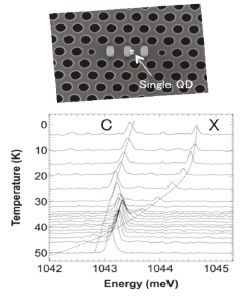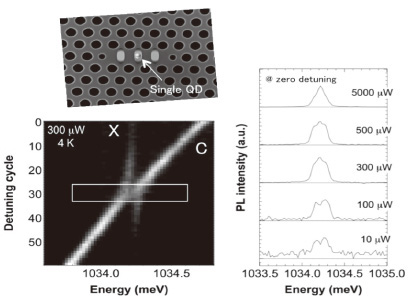Optical Science Laboratory, *Queen’s University
Cavity quantum electrodynamics (cQED) has been intensively studied using
a solid-state two-level system, and has found use for quantum information
devices such as those employing nonlinearities generated by single photons
and the quantum state exchange between light and matter. In solid-state
cQED, however, the environment that surrounds a two-level system is quite
different from that of an atom trapped in a vacuum, and so the interpretation
of its optical response is abstruse [1]. In this study, we explore a novel
optical response in solid-state cQED in weak and strong coupling regimes,
and investigate the corresponding mechanisms.
We used a self-assembled semiconductor quantum dot (QD) as a two-level system that is embedded in a 2D photonic crystal nanocavity. Figure 1 shows a series of PL spectra of a QD exciton (X) and the cavity mode (C) in a weak coupling regime. As the temperature increases, these two peaks experience a continuous redshift thereby reducing the relative energy separation. However, surprisingly, as the two peaks approach one another near the crossover, the cavity modes clearly undergo a blueshift toward the exciton resonance (mode attraction) [2]. In contrast, the PL spectrum in a strong coupling regime exhibits Rabi splitting with anti-crossing dispersion (Fig. 2). When the excitation power is increased, we observe that the Rabi splitting vanishes although anti-crossing is maintained. We analyzed both curious phenomena theoretically in weak and strong coupling regimes. As the result, we proved that these peculiar phenomena in solid-state cQED arise from the large exciton dephasing and the optical radiation characteristics of a 2D photonic crystal cavity [3].
This work was partially supported by the Strategic Information and Communications
R&D Promotion Programme (SCOPE) of Japan.
[1] For example, K. Hennessy et al., Nature 445 (2007) 896.
[2] T. Tawara et al., Opt. Express 18 (2010) 2719.
[3] S. Hughes et al., Opt. Express 17 (2009) 3322.
 |
 |
|||||
|
|